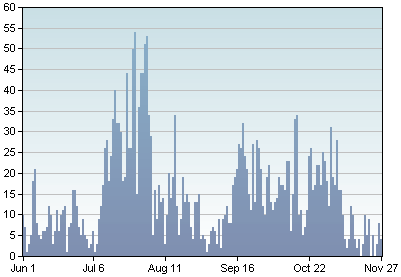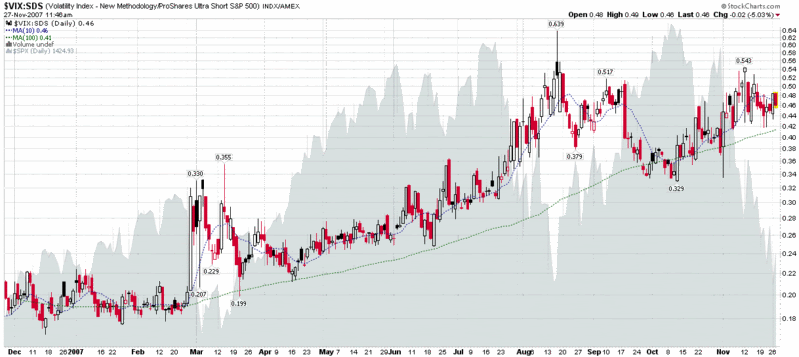Not a Lot of Fear or Volatility Lately
 Given all the gloom and doom headlines across the mainstream media and blogging world (the lines are already blurring, it seems…) I am a bit surprised to see how little journalistic panic (embellishment?) has translated into market panic.
Given all the gloom and doom headlines across the mainstream media and blogging world (the lines are already blurring, it seems…) I am a bit surprised to see how little journalistic panic (embellishment?) has translated into market panic.
Starting with the graphic to the left, which depicts the frequency that the term “VIX” has appeared in blog posts with a certain minimum Technorati authority level over the past 180 days (see original tool), it almost appears as if the VIX is an idea whose time has come and gone. Lately, the talk is all about subprime, CDOs, SIVs, with interest rate spreads as the scorecard de jour. The markets may be down 10%, but with the VIX at 26 and change as I type this, the VIX is not part of the story.
In my ongoing effort to attempt to differentiate between fear and volatility, I turn to the VIX:SDS ratio at moments like these to see how fear has waxed and waned while the markets have fallen rather dramatically. The one year chart of this ratio is below. Previous incarnations of the VIX:SDS ratio chart have all been of the 6 month variety, but I think it is important to look at the current market environment and be able to compare it to the February-March and July-August VIX spikes (the SDS inverse ETF only launched on 6/13/06, so it is not possible to capture the ratio during VIX spike from 5/12/06 to 6/13/06.)
There are many ways to think about this chart (keeping in mind, of course, that it compares an oscillating number with a beta of about -4.2 to a trending number with a target beta of -2.0), but what I keep coming back to is the distance between the current reading or 10 day SMA and the longer-term 100 day SMA. In some respects, this isolates the magnitude of the fear component of the VIX and in the chart below, it underscores how little fear there has been relative to the recent drop in the SPX, especially when compared to similar values in February-March and July-August. I am not sure exactly how to interpret this, but I suspect that either the market will recover to a level that is commensurate with the fear, or perhaps we will see a significant VIX spike well into the 30s that will likely signal a near-term bottom. And despite what you read elsewhere, not all market bottoms require a high volume capitulation session, with an accompanying VIX spike.



4 comments:
Hey Bill,
Could you describe or show an example of a major bottom without a volume and or vix spike? It would be nice to for comparison.
James
Hi James,
I knew I should have had the answer handy before the inevitable question showed up -- and the ink wasn't even dry on my post yet...
OK, since StockCharts.com only has SPX weekly volume going back to 10/98 and since I'm more interested (generally) in the VIX than in SPX volume, I looked at the VIX and SPX on a weekly basis going back to 1990, which is as far back as VIX data goes, and here is my thinking:
A) Classic capitulation (VIX spikes at least 2x above previous levels and volume surges) bottoms appear in Aug-Dec 1991, Mar 1994, Aug 1998, Sept 2001, and July 2002. More recent instances include May-Jul 2006, Feb-Mar 2007, and Aug 2007.
B) Bottoms that lack a significant VIX spike (in the area of 2x above previous levels) include Jul-Sept 1996, Mar 1997, Mar 2001, and Sept-Oct 2002. More recent examples include Mar-Aug 2004 (one bottom or three mini-bottoms), Aug 2005, and October 2005. I am not ruling out the current environment as another one of these 'uneventful bottoms.'
Note that "major bottoms" may mean one thing to one person and other to someone else. I'd be tempted to argue that the only major bottoms we've had since the VIX data begins are 1990 and 2002 -- so the bottoms above are necessarily more of the intermediate and long-term variety.
Cheers,
-Bill
perhaps what we are seeing is also a habitualisation (sp?) problem. We learn from previous proximal lows.
Also on a log scale, there is a scaling issue on the previous mar low, when compared to current market conditions.
I will be looking forward to your next post. Thank you
น้องอาโกะ สาวสวยยิ้มละกดโลก สาวน้อยจาก ม.กรุงเทพ
Post a Comment